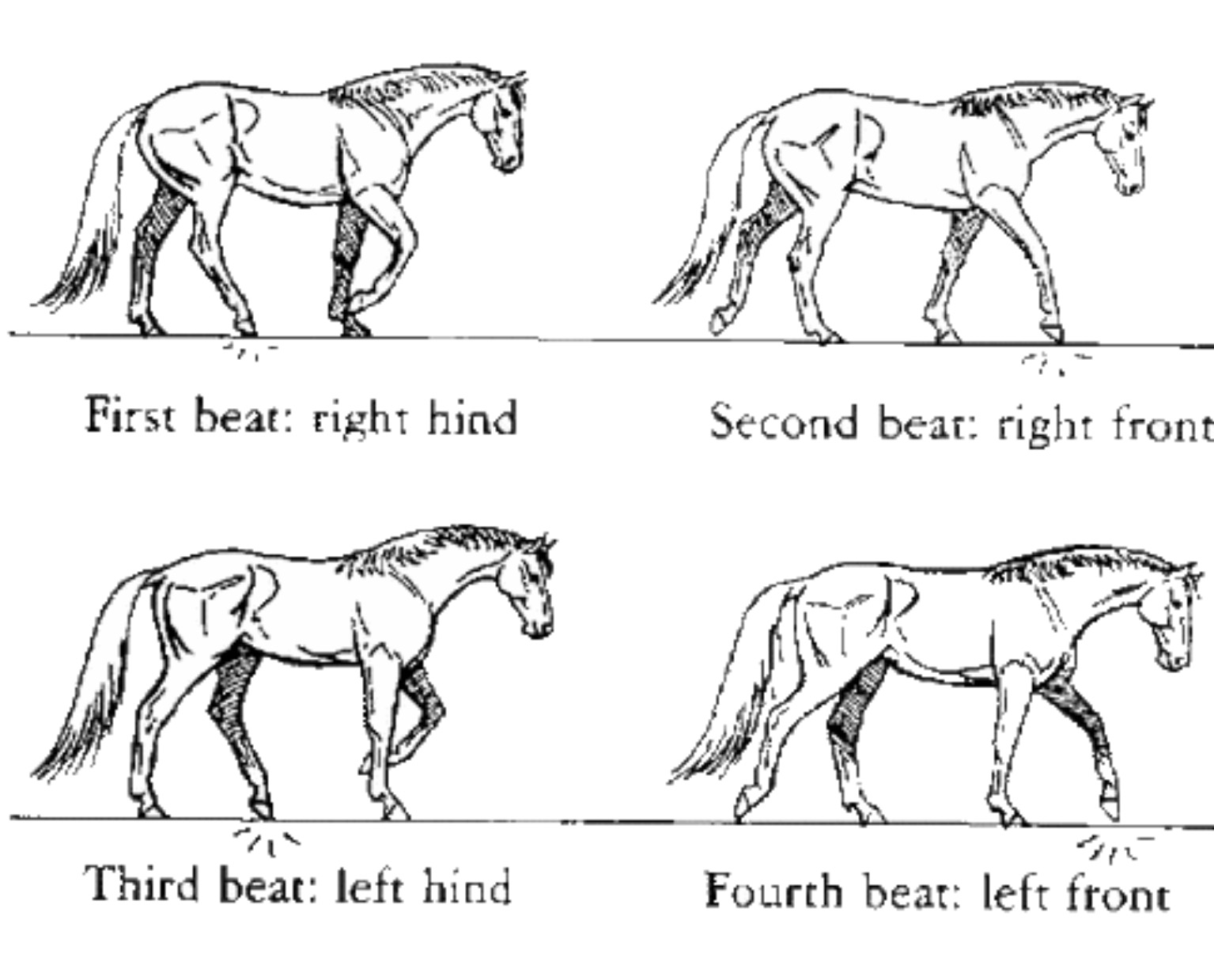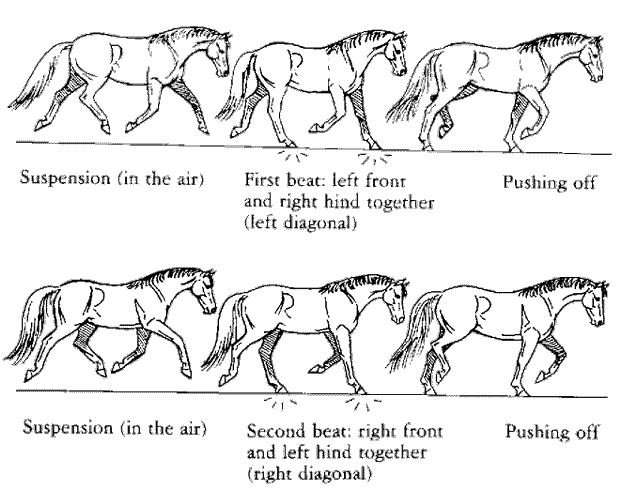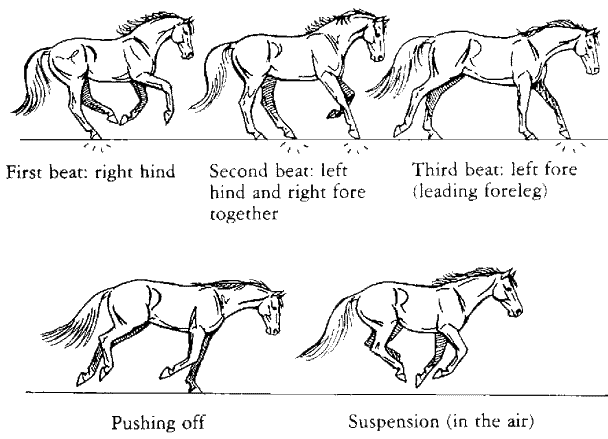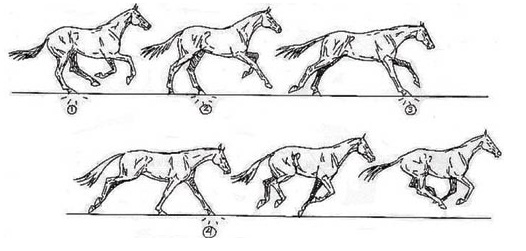Welcome back for part 2 of our discussion on horse gaits! In case you missed the first post, check it out here, so you’re caught up on the terminology I’ll be using in this post. In the previous post we got a basic understanding of what a gait is and why it’s beneficial to know more about them. Now we’re ready to advance to an in-depth look at the mechanics behind each gait. If you’re not familiar with them already, I think you’ll be pleasantly surprised how it will affect your riding! When you hear your instructor talk about doing something specific at a particular gait, you’ll be on the same page in understanding how it works!
As I mentioned in the previous post, we’re going to discuss the 4 basic gaits of the horse and some riding maneuvers we might be asked to do at specific gaits. Let’s get started!
Walk: The walk is a four-beat gait, usually smooth and slow. The horse’s feet move in the following way: a hind foot, followed by the front hoof on that same side, then the other hind foot followed by the other front foot (See photo below for a visual!) This pattern repeats for each stride. As a new rider, the walk is good for learning balance, steering, and gaining strength and feel as a rider. We often practice things like riding in two-point and posting at the walk before we progress to doing these maneuvers at faster gaits. It’s also really helpful to be able to feel the footfall sequence at the walk for events such as trail classes where you have to walk over poles or make tight turns… If you can feel how your horse is moving, it helps you ride and direct your horse in a smoother pattern.
Trot/jog: The trot and jog are the same gait; the jog is technically a western term for a slower moving gait and the trot is an English term for a more ground covering gait. However, they are often used interchangeably and the footfall sequence of horse’s hooves are the same. The trot/jog is a two-beat diagonal gait. That means that one hind foot and the opposite front foot move at the same time, followed by the other hind foot and opposite front foot (See diagram below!). This is considered one stride and then the pattern repeats as the horse keeps trotting.
If you understand the footfall sequence of the trot, it helps posting make sense. Posting is basically when we stand and sit repeatedly in the stirrups in rhythm with the horse’s movement. Every time one diagonal pair of the horse’s legs goes forward, we stand up and then as the other diagonal pair of legs moves forward, we sit in the saddle. This repeated motion over and over is called posting. Posting should be rhythmic with the horse’s stride, soft, and flowing; the key is to let the horse push you up and then you gently sit back down to immediately be gently pushed up again. Another layer to posting is going up on the correct diagonal. When you post on the “correct diagonal,” it means you stand up when the outside front leg and inside hind leg of your horse are going forward. We find the correct diagonal by following the outside shoulder. If you want a trick for remembering what diagonal to be on, just think, “Rise and fall with the leg on the wall.” Can you see how knowing about gaits is so beneficial? Without knowing the footfall sequence of the trot, we’d have no idea what a “correct diagonal” even means!
Canter/lope: The terms canter and lope are often used interchangeably and the footfall sequence of the horse’s hooves are the same. However, technically the lope is western terminology for a slower moving gait and the canter is the English term for a more ground covering gait. The canter/lope is a three-beat gait. The footfall sequence is as follows: the outside hind foot, then the inside hind foot and the outside front foot at the same time, then the inside front foot (see diagram below!)
You’ve probably heard of “canter leads” before, but you may not know what that actually means…. However, as you’ve guessed by now, they have everything to do with the footfall sequence! There is a right and a left lead; the lead you’re on is whichever front leg is “leading.” Or aka, the horse’s front leg that moves on its own and is always slightly more forward. When we are going around the arena to the right or making right turns ect, we want to be on the right lead. If we’re going around to the left, then we want to be on the left lead. Now, sometimes we ask for the “wrong” lead on purpose, in which case we call it counter cantering. Counter cantering would be if you were traveling around to the right, but cantering on the left lead or vice verses. Counter cantering is a more advanced training tool but it’s good to start getting an idea of terminology you’ll most likely hear around trainers who are working horses!
Knowing your canter leads is important for many riding circumstances. While being on the correct lead is super important if you compete in horse shows, it’s also important for practical reasons as well, even if you don’t show. It helps your horse stay more balanced and complete maneuvers more easily.
Gallop: The gallop is the fastest gait. This is the gait you see race horses performing when they’re running down the track. The gallop is a four-beat gait and the footfall sequence is as follows: a hind foot, followed by the other hind foot, then the front foot on the same side as the first hind foot that stepped down, then the other front foot (see diagram below!) That’s considered one stride, and then the pattern repeats just like with the other gaits. It’s rare for the average person to ever ride at a true gallop… most horses and riders, even if they are going REALLY fast, are actually only doing a very fast canter. The horse’s feet still maintain a three-beat pattern so it’s still technically considered a canter. Only when the feet change to four beats can it be considered a gallop. Like I said previously, very rarely will an average horse cross over into a true four-beat gallop.
So there you have it! I hope you enjoyed our adventure into the details of your horse’s gaits! Understanding how your horse moves is the foundation for all the future skills you’ll learn as a rider. Sometimes it can be difficult to understand the more technical details on paper, so please, if you have any questions, feel free to ask! Find me around the barn, or contact me (Rebekah), and I would love to help make everything clear!
See you around the barn!
-Rebekah Bukowski




